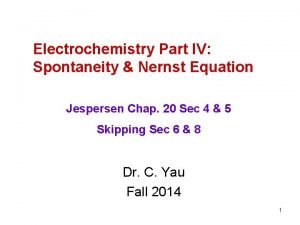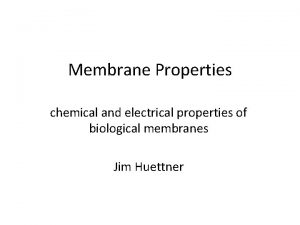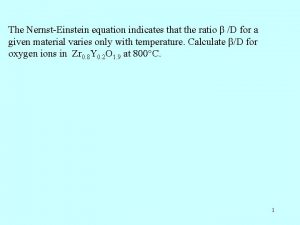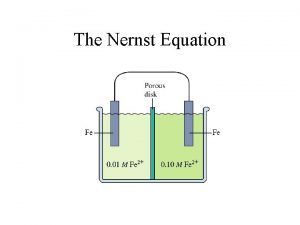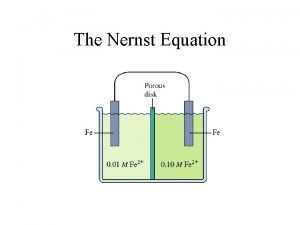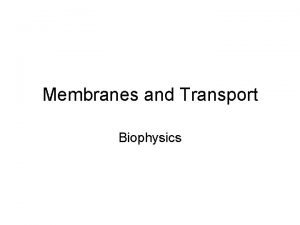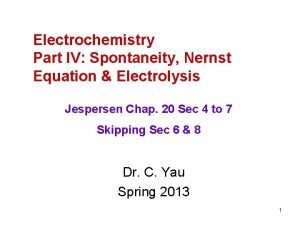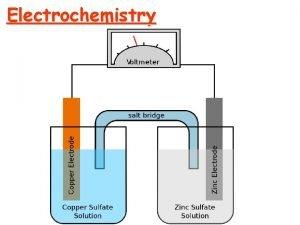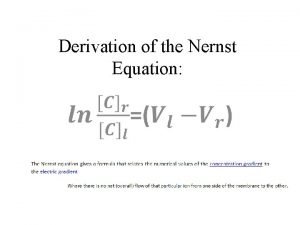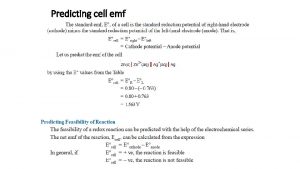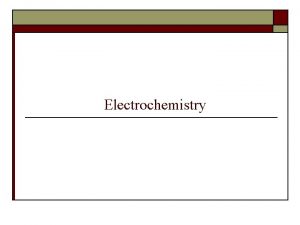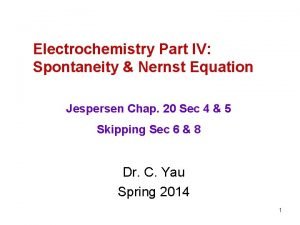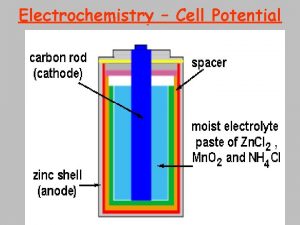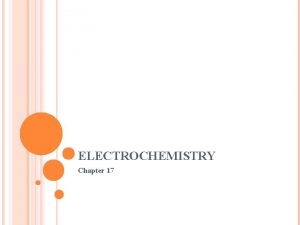Electrochemistry Cell Potential and the Nernst Equation The











- Slides: 11

Electrochemistry Cell Potential and the Nernst Equation

The Electrochemical Cell Producing Copper Lab Source: www. battterybot. com Source: http: //www. reuk. co. uk Alkaline Battery Lead-Acid (car) Battery

The Electrochemical Cell n The species being oxidized LOSES electrons ¨ Occurs at the anode (both start with vowels!) ¨ is the reducing agent ¨ is the more active metal n Will go from metal to ion, thus putting out electrons From the producing copper lab… 2 Cl- (aq) → Cl 2 (g) + 2 e-

The Electrochemical Cell n The species being reduced GAINS electrons ¨ Occurs at the cathode (both start with consonants!) ¨ is the oxidizing agent ¨ is the less active metal n Will go from ion to metal, thus taking in electrons From the producing copper lab… Cu+2 (aq) + 2 e- → Cu (s)

The Electrochemical Cell Cu 2+ (aq) + Zn (s) → Zn 2+ (aq) + Cu (s) 1. 2. Zinc 3. Copper 4. 5. Zn. SO 4 Cu. SO 4 6. Write the oxidation half -reaction Write the reduction halfreaction What is the oxidizing agent? What is the reducing agent? Where is the cathode? Where is the anode? Image: http: //commons. wikimedia. org/wiki/File: Galvanic_cell_unlabeled. svg

The Electrochemical Cell Cu 2+ (aq) + Zn (s) → Zn 2+ (aq) + Cu (s) How can we determine the voltage (the cell potential) created by an electrochemical cell? Zinc Copper Electrons flow from anode to cathode. We can measure this. Zn. SO 4 Cu. SO 4 Image: http: //commons. wikimedia. org/wiki/File: Galvanic_cell_unlabeled. svg

The Electrochemical Cell Cu 2+ (aq) + Zn (s) → Zn 2+ (aq) + Cu (s)

Determining Cell Potentials 1. 2. Write the oxidation and reduction half-reactions Use the standard reduction table to determine: Ecell = Eoreduction + Eooxidation *Remember to flip the sign if you flip the half-reaction! 3. Determine if spontaneous or not: 1. 2. + Ecell = spontaneous - Ecell = not spontaneous

Cell Potential Example Determine the cell potential and say if the reaction is spontaneous as written: Mn 2+(aq) + 4 H 2 O(l) + Sn 2+(aq) → Mn. O 4 -(aq) + 8 H+(aq) + Sn(s)

The Nernst Equation n Until now, we have been calculating cell potentials at standard conditions (1 M, 25 o. C, and 1 atm). How do we calculate cell potentials under NON standard conditions? At standard temp, this simplifies to:

Nernst Equation Example Find the cell potential for the following reaction at 25°C if [Cd 2+] = 0. 020 M and [Pb 2+] = 0. 200 M. Cd 2+ (aq) + Pb (s) → Pb 2+ (aq) + Cd (s)
 Nernst potential equation
Nernst potential equation Nernst equation class 12
Nernst equation class 12 Goldman hodgkin katz equation
Goldman hodgkin katz equation Oxidation and reduction in galvanic cells
Oxidation and reduction in galvanic cells Nernst einstein equation
Nernst einstein equation Nernst equation calculator
Nernst equation calculator What is e in nernst equation
What is e in nernst equation How to do redox reactions
How to do redox reactions Goldman equation
Goldman equation Nernst equation electrolysis
Nernst equation electrolysis Electrochemistry
Electrochemistry Nernst equation wikipedia
Nernst equation wikipedia

